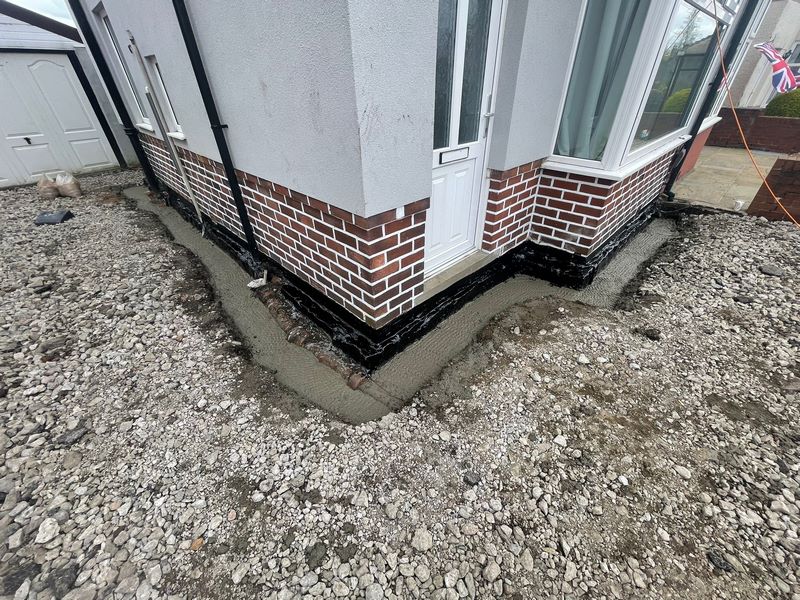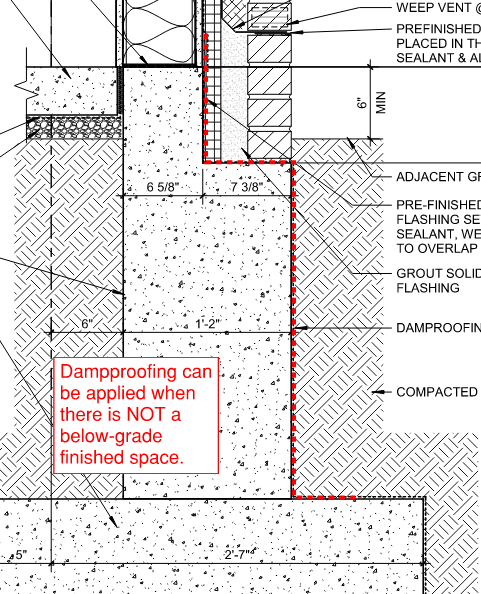Exploring the Various Methods and Solutions for Effective Damp Proofing
Wetness in buildings presents substantial obstacles to both structural honesty and interior air top quality. Different techniques and services have arised to fight this prevalent issue. From traditional damp-proof membrane layers to ingenious chemical treatments, each technique offers distinct advantages. Recognizing these alternatives is vital for efficient wetness control. Nonetheless, selecting the appropriate solution depends on details structure conditions and requirements, triggering more expedition right into the most efficient moist proofing approaches offered.
Understanding the Sources Of Dampness
Although moisture can occur from different resources, recognizing these reasons is important for reliable removal. Generally, wetness originates from 3 primary sources: rising moist, passing through wet, and condensation. Rising wet occurs when groundwater takes a trip up-wards with permeable materials, such as brick or stone, frequently as a result of an absence of a reliable barrier (damp proofing newcastle). Penetrating damp is generally brought on by external factors, consisting of roofing leakages, malfunctioning seamless gutters, or harmed wall surfaces, allowing water to infiltrate a residential or commercial property. Condensation, on the various other hand, arises from excess moisture in the air, often intensified by poor ventilation and temperature level differences, leading to water beads basing on surfaces. Determining these underlying problems is necessary, as each type of dampness needs a customized technique for remediation. Appropriate assessment assists in establishing the most efficient services, inevitably guarding the structural honesty of a structure and boosting indoor air top quality
Traditional Damp-Proof Membranes

Chemical Damp-Proofing Solutions
Chemical damp-proofing remedies provide an ingenious strategy to stop wetness invasion in buildings. These techniques usually entail the application of fluid chemicals that penetrate stonework and develop a barrier versus climbing damp. Typically utilized chemicals include silanes, siloxanes, and various other water-repellent agents that react with surface area materials to develop a hydrophobic layer.The application procedure usually needs boring holes right into the wall surfaces, injecting the chemical remedy, and permitting it to heal. This approach is specifically helpful for older structures where typical damp-proof membrane layers may be impractical. In addition, chemical damp-proofing can be much less disruptive and more economical than considerable remodelling projects.While effective, these remedies depend upon proper application and environmental problems for peak efficiency. Regular maintenance and monitoring are important to ensure the long life of the damp-proofing therapy. Generally, chemical damp-proofing represents a versatile alternative for guarding structures against moisture-related damage
Tooth Cavity Wall Building Methods
Tooth cavity wall building methods offer numerous benefits, specifically in dampness control and energy efficiency. By incorporating an air gap in between two layers of stonework, these wall surfaces successfully mitigate water access while improving insulation. This mix not only safeguards frameworks from moisture yet additionally adds to minimized energy usage.
Benefits of Cavity Walls
When taking into consideration reliable moist proofing methods, the benefits of tooth cavity walls stand out prominently. Dental caries wall surfaces contain 2 separate layers, producing an air void that effectively reduces moisture infiltration. This style lessens the risk of moisture, as the external wall serves as an obstacle against rain and water ingress. Furthermore, tooth cavity walls improve thermal insulation, which adds to power efficiency by reducing heat loss. They additionally offer audio insulation, aiding to create a quieter indoor atmosphere. The air space allows for ventilation, which assists in dampness control and lowers the chance of mold and mildew development. These benefits not only improve the general comfort of a structure however additionally add to its long life and architectural stability.
Moisture Control Strategies
Efficient moisture control strategies are vital in dental caries wall building to guarantee lasting protection versus dampness. One key method includes the consolidation of weep openings, which assist in water drain from the cavity, protecting against build-up. Additionally, making use of breathable membranes can aid manage dampness levels while enabling trapped vapor to run away. Appropriate placement of insulation is likewise crucial, as it must not obstruct drainage paths. Making sure that the external fallen leaves of the dental caries wall are built with water-resistant products enhances overall durability. Regular maintenance checks are vital to recognize any kind of clogs or damage early, protecting the framework's integrity. Ultimately, a mix of these strategies develops a robust defense against wetness invasion in tooth cavity wall surfaces.
Insulation and Power Performance
Insulation plays an essential role in enhancing energy effectiveness within cavity wall surface building. By including protecting products, these walls develop a thermal barrier that minimizes warmth loss and decreases power intake. Reliable insulation not just aids keep a secure interior temperature level yet additionally reduces the threat of wetness, as it stops condensation within the wall surface tooth cavity. Different methods, such as the usage of rigid foam boards or mineral woollen, can be used to accomplish suitable insulation performance. In addition, appropriate setup is crucial to guarantee that voids and gaps are reduced, which can or else endanger power effectiveness. Eventually, a well-insulated cavity wall surface adds substantially to total sustainability and lowers cooling and heating prices for homeowners.
Outside Damp Proofing Techniques
Outside moist proofing methods are vital for safeguarding frameworks from moisture seepage. Two efficient techniques include the application of water resistant membranes and the installation of French drains pipes. These remedies assist mitigate water buildup and maintain the integrity of structures.
Waterproof Membrane Application
While numerous methods exist for preventing wetness access, the application of waterproof membranes stays an extremely efficient outside wet proofing technique. These membrane layers are commonly made from products such as polyethylene, rubber, or changed asphalt, offering a robust obstacle against water penetration. The installment process involves using the membrane to the external surface areas of walls or structures, making certain full coverage to stop leaks. Appropriate attachment and securing at joints are crucial to taking full advantage of performance. Waterproof membrane layers can be used in numerous kinds, including fluid finishes and sheet membrane layers, permitting flexibility based upon the certain needs of the framework. This method not just safeguards structures from wetness yet also enhances their long life and architectural stability.
French Drain Setup
One efficient method for handling groundwater and avoiding wetness build-up around a structure's foundation is the installment of a French drain. This drain system contains a trench full of gravel and a perforated pipeline that redirects surface area water away from the foundation. Proper installment needs careful planning, guaranteeing that the drain slopes away from the structure to help with suitable water flow. Furthermore, the location of the drain is vital; it must be positioned in areas vulnerable to pooling or excess wetness. Normal upkeep, including clearing up debris from the crushed rock and ensuring the pipe continues to be unobstructed, is vital for long-lasting effectiveness. Ultimately, a well-installed French drain can greatly decrease the risk of water-related problems in structures and cellars.
Inside Waterproofing Approaches
Interior waterproofing methods are vital for shielding a structure's interior from dampness seepage and possible water damages. These techniques generally entail the application of specialized products and methods created to produce a wetness barrier within the framework. One typical strategy is the use of water resistant finishings or sealers on walls and floors, which avoid wetness from penetrating surfaces.Additionally, setting up indoor drain systems, such as sump pumps, can properly handle water accumulation in cellars and crawl areas. Another technique involves making use of vapor obstacles, which are mounted to hinder dampness motion from the ground right into living spaces.Moreover, dealing with any kind of splits or spaces in wall surfaces or structures with proper sealers guarantees a complete protection against water breach. By implementing these interior waterproofing approaches, homeowner can greatly reduce the threat of mold and mildew development, structural damage, and various other moisture-related concerns. Proper implementation of these strategies is vital for long-lasting protection and structure integrity.
Normal Maintenance and Assessment Practices
Normal maintenance and evaluation practices are crucial for guaranteeing the long-term efficiency of wet proofing services in any structure. Regular checks enable building proprietors to identify very early indicators of moisture invasion, such as peeling paint, mold and mildew development, and mildewy odors. These signs can signify underlying problems that require instant attention.Inspections ought to be carried out a minimum of yearly, concentrating on susceptible locations like basements, creep spaces, and exterior walls. During these analyses, home proprietors need to check out sealers, drainage systems, and air flow to confirm they operate correctly.Additionally, preserving rain gutters and downspouts is essential, as clogged up systems can lead to water buildup near the foundation. Executing a regular maintenance timetable, in addition to timely repair services, can considerably expand the life-span of moist proofing actions and safeguard the structural integrity of the building. Positive procedures eventually contribute to the total health and wellness of the living environment.
Frequently Asked Questions
Exactly How Lengthy Does Damp Proofing Normally Last?
The duration of damp proofing efficiency differs, normally lasting in between 20 to half a century. Variables such as application top quality, environmental conditions, and maintenance practices considerably influence the durability of the moist proofing therapy.

Can I Damp Proof My Home Myself?
The specific pondered the expediency of do it yourself damp proofing. With correct research and the ideal materials, it is feasible. They additionally recognized the value of specialist advice to guarantee lasting effectiveness and protect against future problems.
What Are the Signs of Ineffective Damp Proofing?
Signs of inadequate moist proofing consist of consistent mildewy odors, visible mold development, peeling off paint, damp spots website on wall surfaces, and wood decay - mould removal newcastle. House owners need to attend to these problems quickly to avoid additional damage and wellness concerns
Does Damp Proofing Affect Indoor Air Top Quality?

Just How Much Does Professional Damp Proofing Expense?
Expert wet proofing expenses vary significantly, typically ranging from $1,000 to $5,000 relying on the building's size, the degree of the wet issue, and selected techniques. Each circumstance calls for a tailored analysis for precise prices. Commonly, dampness stems from three main resources: climbing moist, permeating moist, and condensation. When considering reliable wet proofing techniques, the benefits of tooth cavity wall surfaces stand out plainly. Exterior wet proofing methods are crucial for protecting structures from dampness seepage. While different techniques exist for stopping moisture ingress, the application of water-proof membranes remains a very efficient exterior moist proofing technique. Indicators of inadequate wet proofing consist of consistent stuffy smells, visible mold and mildew growth, peeling paint, damp spots on walls, and wood decay.